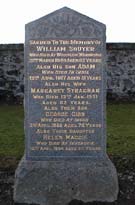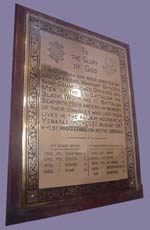In Memory ofEDWARD ADAM SOUTERPrivate
|
|
Additional Information: Click on images to view details
|
Son of William and Margaret Souter, of Woodside Cottage, Wardhouse,
Insch, Grampian. William Souter d Woodside, Wardhouse 22/3/1940
age 82, Margaret Strachan d 12/1/1951 age 82. EA Souter, Whiteburn on Memorial. Father
farming there 1917-18, V Roll Army Casualty Returns: Died in railway
accident (3 others listed same cause and date) The letter S prefixing the service number indicates a wartime enlistment. Victory Medal only, Medal Roll info In The Roll of Railwaymen killed in WW1,The
Great North Scotland Railway is shown on pages 46-47 and gives
the following details His name is recorded on the Fallen Employees Memorial on the concourse of Aberdeen Railway Station 12/3/1917 Service Notes
|
Commemorative Information
| Memorial: |
MADRAS 1914-1918 WAR MEMORIAL, CHENNAI, India Face 18. |
Location: |
The Madras
1914-1918 Memorial is situated in Madras War Cemetery at the far
end of the main path from the entrance, beyond the Stone of
Remembrance and the Cross of Sacrifice. The Memorial consists of a
stone wall 15 metres long and 2 metres high, on which are 2
inscription panels, one at either end of the wall; one in English
and one in Hindi. Inscribed on the stones on both sides of the
wall are the names of one thousand servicemen who served in
garrisons and died in India during the 1914-1918 War and who lie
buried in civil and cantonment cemeteries in the former States of
the Andaman Islands, Assam, Bengal, Bihar, Hyderabad, Madras,
Mysore, Orissa and Uttar Pradesh, which have since been found
impossible to maintain adequately. Madras War Cemetery is about 5
kilometres from the airport and 14 kilometres from the central
railway station. The GST Road (Great Southern Trunk Road) leads
from the airport past Trident Hotel to Kathipara roundabout -
there is a Commonwealth War Graves Commission road direction sign
on a small triangular island showing the way to the cemetery via
Mount Poonamall Road, passing at the foot of St. Thomas Mount. The
cemetery can easily be located on the right hand side of the road
1 kilometre from St. Thomas Mount. From Madras Central Railway
Station the route is up Mount Road (Anna Selai) and over the
bridge which crosses the River Cooun. The route passes St. Mary's
Cemetery on Pallawan Road and is via LIC building (Life Insurance
Corporation Building) situated on Mount Road, which leads to Anna
Flyover and to Kathipara Junction. |
| Historical Information: |
Afghanistan on the West, and Afghanistan on the North. Persia and Turkestan were full of disciplined or informal armies conducting confused wars; the friendly governments that emerged in the former Russian Empire, after Brest-Litovsk, were gradually giving way, and the various Soviet Republics, which Allied forces were definitely fighting at many points, were firmly established in the course of the year. Serious riots broke out in the Punjab in April; and the Afghans invaded India in May. Once more, it was fortunate that India's enemies fought her one by one. vi Habibulla, Amir of Afghanistan, by whose coolness and tenacity the Afghan army had been kept out of the War, was murdered on the 20th February, 1919, and Amanulla Khan ascended the throne on the 28th. On the 3rd May Amanulla's forces entered India near Landi Kotal, between Jalalabad and Peshawar, and the Third Afghan War was declared on the 6th. By the 13th May, British troops had driven these invaders across the frontier and occupied Dakka. The fighting on the Khyber front lasted until the 17th May; after that date, no Afghan troops were found in this area. Jalalabad was bombed from the air, and preparations were made to advance on the town. Meanwhile, North of the Kabul river, another Afghan force had invaded the Mohmand territory, but dispersed without attempting to pass the old line of the Blockade. On the 26th, however, a new phase of the war began; Afghan troops advanced on Thal by the Kurram valley, and two days later another force moved towards Jandola, in the Mahsud country, in North Waziristan. The North and South Waziristan Militia mutinied, and Thal was invested, but relieved on the 3rd June. Since the 15th May an Afghan envoy had been unofficially negotiating for peace, and on the 31st the Amir asked for an armistice, which was granted on the 3rd June. The Afghan Army ceased to fight; but Afghan diplomacy continued to work on the tribesmen, who had hitherto been quiescent, and guerrilla warfare went on until August from Dakka back to Peshawar. To the far North, Chitral had had its own war, successfully conducted by the Chitral Scouts, the Mehtar's Bodyguard and the 1/11th Rajputs. The fighting in Baluchistan remains to be described. It began with the British capture, on the 27th May, of Spin Baldak, a fort four miles over the Afghan border from Chaman, about midway between Quetta and Kandahar. At the beginning of June it spread to Zhob, the North-East corner of the territory, where desperate small-scale fighting with the tribes took place and Fort Sandeman was actually besieged from the 27th July until early in August. The fighting in Zhob, in which the Afghan Army took no part, outlasted the war. On the 26th July, a peace conference was opened at Rawalpindi, and on the 8th August a preliminary peace was signed; but it was not until the 22nd November, 1921, that the Treaty of Kabul redefined the relations of India and Afghanistan. 1919-24: Waziristan. The Afghan War was followed by five years of unrest and intermittent fighting in Waziristan. The Registers of the Imperial War Graves Commission were closed, under its Charter, at the end of August, 1921, and the Madras 1914-1918 Memorial does not record the names of those who fell after that date; but the long and difficult campaigns against Mahsuds and Wazirs, with which the British Empire ended more than ten years of continuous warfare, may properly be described as a whole. The valleys of the Tochi, the Tank (or Takki) Zam and the Gumal lead from Bannu and Tank into Waziristan; and when the Afghan War ended British troops held the three valleys as far West as Miranshah, Jandola and Murtaza. The tribes were actively hostile, and it was evident that extended operations, and perhaps a new policy in Waziristan, were necessary. By November, 1919 a force of 63,000 officers and men were ready to invade the barren mountains from which, since the previous May, British posts and occupied towns had been incessantly raided. The Tochi Column advanced from Miranshah to Datta Khel, and the Tochi-Wazirs accepted the British terms; but the Mahsuds, summoned to meet near Jandola, refused to attend the 'jirga'. On the 18th December the Derajat Column began its advance from Jandola against the Mahsuds. Deliberately advancing on the single line of the Tank Zam, it came within four miles of Kotkai on the 28th December after very severe fighting. On the following day terms were accepted, and very quickly broken, by the Mahsuds. By the 18th January, 1920, the Ahnai gorge had been forced and the Sorarogha plateau occupied. The Makin area, far up the Tank Zam, was reached late in February, and Kaniguram, the Mahsud capital, on the 6th March; and by the 7th May resistance had ceased. A permanent camp, to accommodate an infantry brigade, was formed at Ladha, five miles short of Kaniguram. The campaign had been won by Indian infantry, the Royal Air Force, and the protection of the lines of communication by permanent piquets at fairly close intervals; it had cost the British forces more than 600 dead. The Wana-Wazirs, in South Waziristan, were called to account in October, 1920, for hostile acts committed in and since 1919, and the British terms were not accepted. The Wana Column, advancing by the Shahur gorge and Sarwekai, reach Wana in six weeks, by the 22nd December. Permanent garrisons were placed in South Waziristan. In these operations, and other minor affairs from November 1920 to March 1921 inclusive, the British forces on the frontier lost 376 dead. From April 1921 to the Spring of 1924 spasmodic raids, gradually becoming fewer, were answered by punitive expeditions and controlled by the introduction of a new frontier system. Makin, the capital of the Abdullai Mahsuds, was shelled in June, 1921, and devastated in February, 1923. Fifty-four casualties were sustained by convoys near Janjal in May, 1921, 50 near Jandola in June, and 82 in the Spinchilla Pass in December, 1921; less important losses in March and April, 1922, and in January and March, 1924. Meanwhile truck roads were built; local levies (Scouts and Khassadars) were enlisted, trained and placed at advanced posts; and the regular forces were gradually withdrawn with the exception of a central garrison at Razmak (at the head of the Taoda China valley, above Makin; communicating with the Khaisora and Tochi valleys). On the 31st March, 1924 the Waziristan Force was dispersed. Madras is the chief city of Tamil Nadu State. It lies on the Bay of Bengal, half-way between the rivers Pennar and Ponnaiyar, and is crossed by the little river Cooum. About 16 kilometres south of the city is St Thomas's Mount, traditionally the place where St Thomas the Apostle was martyred, and the reputed site of his tomb. It is said that King Alfred the Great sent Bishop Swithelm of Sherbourne to India to visit this Saint's shrine. A small Christian shrine still exists there. The 1914-1918 Memorial is situated at the rear of the cemetery and opposite the entrance feature. It consists of a stone wall 15 metres in length and 2 metres high. There are 2 inscription panels, one at either end of the wall; one is in English and one is in Hindi. The names are inscribed on the stones on both sides of the wall. This Memorial bears the names of those who served in garrisons and died in India during the 1914-1918 War and who lie buried in civil and cantonment cemeteries in the former States of the Andaman Islands, Assam, Bengal, Bihar, Hyderabad, Madras, Mysore, Orissa and Uttar Pradesh. The cemeteries in which they lie, and which have since been found impossible to maintain adequately, are as follows: AGRA CANTONMENT CEMETERY BEZWADA EUROPEAN CEMETERY (including Havelock Cemetery) BOLARUM CAVALRY BARRACKS CEMETERY, ALIGARH CIVIL CEMETERY SECUNDERABAD ALLAHABAD NEW CANTONMENT CEMETERY CALCUTTA (ENTALLY) CEMETERY AROGYAVARAM POT |



